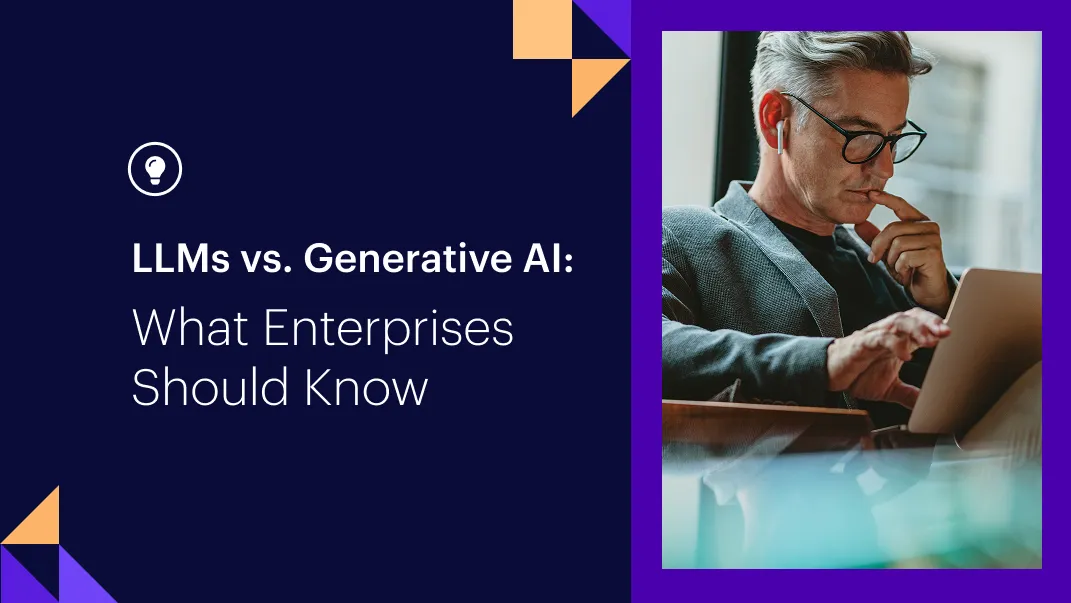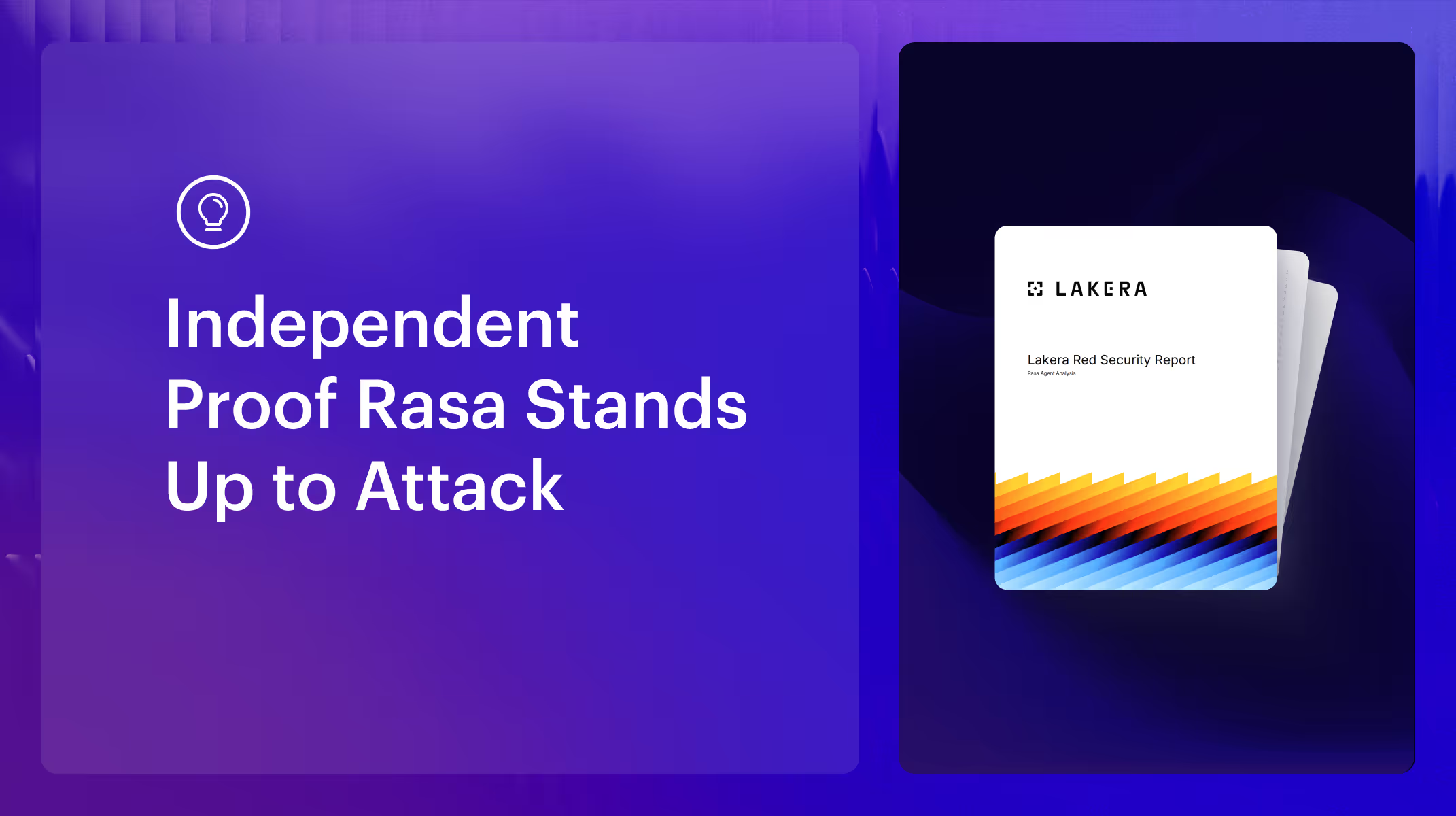You’ve probably used a chatbot that left you frustrated. It could answer a simple FAQ, but the second you asked something unexpected or gave more detail than it was designed to handle, it hit a wall. That’s because most early chatbots were built on rigid scripts.
Large language models (LLMs) have made it possible to design a new class of conversational AI assistants-LLM agents-that can adapt to changing context, handle multi-step requests, and even connect to external systems to complete tasks. In other words, they’re built for the unpredictability of real-world conversations, where dialogue rarely follows a straight line.
Below, we’ll break down what LLM agents are, how they differ from traditional chatbots, and why enterprises are adopting them for advanced, reliable AI experiences.
What is an LLM agent?
An LLM agent is a goal-oriented chatbot that handles more than simple responses. Instead of relying on decision trees or intent matching, it uses a large language model and generative AI techniques to answer questions, reason, plan, and take action across tasks or conversations.
While a basic chatbot follows predefined paths, an LLM-powered chatbot works dynamically to deliver outcomes.
As a simplified example: A traditional chatbot is like navigating a phone menu (e.g., “press 1 for billing, press 2 for support”), and if the caller’s request doesn’t fit, they’re stuck.
By contrast, an LLM agent communicates in natural language, adapts on the fly, and keeps track of context with short-term or long-term memory. If a caller switches gears mid-conversation, it can adjust seamlessly and still connect the steps needed to help the caller reach their goal.
How LLM agents differ from traditional chatbots
Basic chatbots helped kick off conversational automation, but they came with clear limits. Their scripted logic worked for FAQs but fell apart when conversations grew more nuanced. LLM agents add reasoning, adaptability, and integration capabilities that take conversational AI far beyond rule-based scripts. Here’s how they do it:
Reasoning and dynamic task handling
LLM agents are goal-oriented. They plan, sequence, and execute steps to reach an outcome. Using chain-of-thought reasoning, they can break down a user goal into smaller tasks, update the plan as new details emerge, and keep the conversation on track.
Say, “Schedule a meeting, send the invite, and attach last quarter’s sales report,” and the agent can check the calendar, draft the invite, retrieve the report, and complete the workflow autonomously.
A traditional chatbot can do this only if every path is scripted in advance. By contrast, an LLM agent’s decision-making combines prompted chain-of-thought reasoning, algorithms, and tool use (APIs, databases, workflows) to parse the request, choose the next best action, and deliver a coherent result even when the request isn’t pre-scripted.
Flexible dialogue adaptation
Traditional chatbots struggle the moment conversations veer off script. Say someone is updating their shipping address and asks, “What’s your refund policy?” The system often can’t handle both. That’s the limitation of rigid, rule-based chatbots. They expect conversations to move in a straight line, but real dialogue doesn’t work that way.
LLM agents adapt in real time. If a caller shifts topics, asks a side question, or changes direction mid-conversation, they can weave the new input into the dialogue and then return to the original task. This ability to balance multiple threads makes interactions feel natural and more like talking to a human.
Integrations with external tools and APIs
Most chatbots stop at giving answers within the boundaries of their script. LLM agents, on the other hand, are built for real-world tasks. They can connect to APIs, databases, and transactional systems, enabling more than simple message exchanges.
For example, an LLM agent might pull account details from a CRM, check product availability in an inventory system, or process a payment through a secure integration using function calling.
That shift turns conversations from informational to actionable. Instead of only telling a user how to solve a problem, the agent can actually solve it: booking an appointment, resetting a password, or onboarding a new customer. Behind the scenes, these actions are supported by external tools, modules, and agent frameworks that coordinate the subtasks.
Orchestration and safety layers
Of course, greater capability requires stronger control. While an LLM agent can generate answers, retrieve data, or take action, it needs guardrails to determine when each is appropriate. That’s where orchestration frameworks offer major value.
Think of orchestration as the control center. It directs the agent to respond safely, pull from trusted knowledge bases, escalate to a human for sensitive issues, or pause when uncertain.
These safety layers protect customer data, ensure compliance, and build trust, while still allowing enterprises to realize the benefits of advanced automation.
How agent systems manage more sophisticated tasks
LLM agents rarely operate alone. In enterprises, they’re often part of broader systems that coordinate multiple assistants to handle complex tasks, long customer journeys, or compliance-heavy processes. Instead of one agent attempting to cover everything, responsibilities are distributed across specialized roles, making the system scalable and effective.
Coordinating AI agents through agent systems
An agent system works like a team of AI assistants operating in sync. One might authenticate a user, another retrieve account details, and a third explain options or complete the next step. To the customer, it feels like a single smooth conversation, but behind the scenes, multiple components are collaborating.
This structure is becoming essential for large enterprises because it lets you scale conversational AI across departments and workflows without overloading one agent. For teams moving beyond pilots, it provides a strong foundation for putting agents into production at scale.
Fine-tuning LLM agents for enterprise needs
Every industry speaks its own language. A healthcare provider, a telecom company, and a bank all rely on different terminology, processes, and compliance rules. Fine-tuning ensures your LLM agents can operate within those boundaries.
By training on domain-specific datasets, LLM agents can understand specialized vocabulary, follow industry regulations, and adapt to workflows unique to your business.
This fine-tuning builds on the foundation of LLM training, which equips the model with general language capabilities. That way, they don’t just sound intelligent-they act intelligently, and in context.
The importance of long-term memory in agents
Conversations with customers don’t always begin and end in one session. A customer might return days or weeks later, expecting the system to “remember” them. Long-term memory lets LLM agents store user history, preferences, and context across sessions.
That continuity enables more personalized experiences, whether recalling past orders, remembering preferred settings, or picking up where a conversation left off. It also builds trust and drives loyalty.
How autonomous agents drive greater efficiency
Autonomous agents push the boundaries of what’s possible. Instead of waiting for human input, they can reason, act, and escalate only when needed.
Imagine one detecting a billing error. It pulls up the customer’s account, verifies the discrepancy with data analysis, applies the correction, and notifies the customer all without a human ever stepping in.
If something looks unusual or falls outside its scope, then it escalates the issue to a person. This independence reduces manual workload, speeds resolution, and frees your team to focus on higher-value priorities.
Why enterprises are exploring LLM agents
LLM agents are quickly moving into the mainstream, with 79% of organizations already using AI agents in some capacity.
What’s behind the adoption? These digital agents can automate complex workflows, lighten the burden of scripted logic, and create experiences that feel natural for both customers and employees.
Here are the top reasons enterprises are making the shift:
Unlocking more complex use cases
Traditional chatbots were limited to FAQs and simple triage. LLM agents handle multi-step, high-value workflows and solve complex problems spanning troubleshooting, account verification, and personalized recommendations, all with a single, frictionless flow.
Enterprises are also using agents to streamline onboarding and automate repetitive back-office tasks. It’s no surprise that analysts expect rapid growth: Gartner predicts that by 2026, nearly 30% of enterprises will automate more than half of their operations using AI and LLMs.
By taking on work once too complex for scripted systems, LLM agents are expanding what automation can achieve and broadening the scope of LLM applications across industries.
Reducing reliance on scripted workflows
Enterprises once spent months building exhaustive decision trees to cover every possible user path. LLM agents lift much of that burden by interpreting intent in real time and choosing the next best step. This adaptability reduces upfront development while keeping conversations relevant when customers go off script.
For example, in a traditional system, a request to “change my subscription” might only trigger a predefined cancellation flow. But an LLM agent can clarify whether the customer wants to upgrade, downgrade, or pause, and then connect directly to the right backend system. That flexibility makes automation more resilient and better aligned with how real customers behave.
Improving customer and employee experiences
The biggest payoff comes from better experiences. For customers, LLM agents enable self-service that feels natural instead of menu-driven. For employees, they act as smarter assistants, retrieving information, drafting responses, or handling repetitive tasks.
The result is faster, more accurate interactions that benefit the customer and your business: Customers get the service they expect, employees focus on higher-value problem-solving, and the organization benefits from stronger satisfaction and efficiency.
Tips for building smarter LLM agents with advanced techniques
To make LLM agents truly reliable at scale, you need techniques that add structure, accuracy, and control. Methods like retrieval augmented generation (RAG), ReAct (Reasoning and Acting) prompting, and multi-agent orchestration help transform an assistant from sounding intelligent to delivering real business value.
Follow these tips to design enterprise-ready AI assistants:
Enhance responses with retrieval-augmented generation
One of the biggest risks with LLMs is hallucination, when the model generates convincing but false information. In casual use, it’s a nuisance. But in an enterprise setting, it can lead to compliance issues, misinformation, or frustrated customers.
RAG addresses this by pulling answers directly from trusted sources (e.g., knowledge bases, policy documents, or live databases) before the assistant responds. For example, if an employee asks about healthcare benefits, the agent won’t “guess” from training data. It retrieves the latest details from the HR portal and responds with confidence.
Combining RAG with embedding indexes and semantic retrieval improves accuracy, consistency, and trustworthiness. Regular benchmarking and optimization of the retrieval layer further reduces hallucination risk.
Enable better planning through ReAct
LLMs are great conversationalists, but they don’t always know what to do next. Should they answer now, fetch more data, or escalate the issue to a human? ReAct provides a framework: reason through the request step by step, choose the best course of action, observe the result, then continue.
For example, if a customer asks about a suspicious charge, a ReAct-powered agent might:
- Verify account details to confirm identity and context.
- Pull recent transactions and related metadata.
- Decide the next move, whether it’s to escalate to fraud support if criteria are met, or explain findings and next steps if not.
This structured reasoning turns the assistant from a responder into a decision-maker, ensuring more reliable outcomes, clearer reasoning paths, and smarter escalation.
Orchestrate workflows with multi-agent systems
Enterprises rarely rely on a single assistant to do everything. A more effective design is a multi-agent system where each agent specializes in areas like payments, compliance, or onboarding. Together, they manage larger workflows while still feeling like one seamless interaction for the user. These systems are often built as modular agent systems with clear dependency management between modules.
Take customer support as an example. One agent verifies identity, another retrieves account history, and a third suggests personalized solutions. An orchestration layer coordinates the handoffs so the customer only experiences a smooth conversation.
The beauty of this approach is agility. If compliance rules change, you can update the compliance agent without affecting the others. That flexibility keeps assistants aligned with evolving policies, customer needs, and business priorities, without requiring a full rebuild.
Build smarter, safer LLMs with Rasa
LLM agents are transforming conversational AI, moving beyond fixed flows to assistants that can reason, adapt, and act with dynamic, goal-driven orchestration. They allow enterprises to automate multi-step processes, support natural dialogue, and create better experiences for customers and employees alike.
But raw model power isn’t enough. To succeed, enterprises need assistants with flexibility, coordination, long-term memory, and secure integrations. The Rasa Platform provides the open, secure framework to design and deploy assistants that perform reliably at scale. Instead of being locked into a black-box tool, you gain full control to integrate with existing systems, maintain compliance, and fine-tune workflows for your industry.
**Ready to reimagine what conversational AI can do? Connect with Rasa and start building AI assistants that are smarter, safer, and built for enterprise.
**






